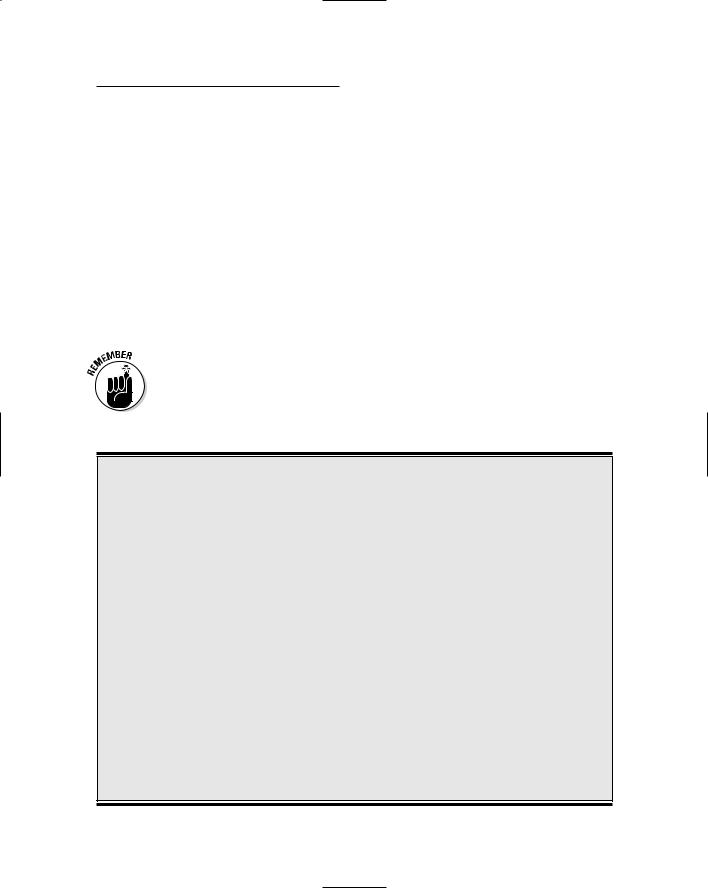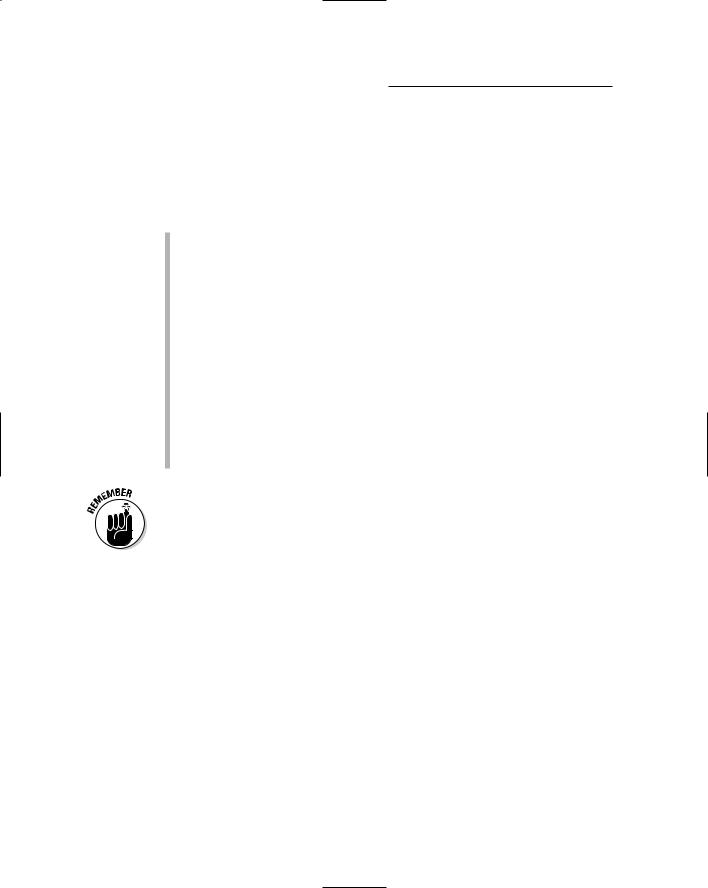
Accounting For Dummies, 4th edition
.pdf
190 Part III: Accounting in Managing a Business
Transportation costs of delivering products to customers via FedEx, UPS, and freight haulers (railroads and trucking companies)
Fees that a retailer pays when a customer uses a credit or debit card
Cost of goods sold is usually the largest variable expense of a business that sells products, as you would suspect. Other variable expenses are referred to as operating expenses, which are the costs of making sales and running the business. The sizes of variable operating expenses, relative to sales revenue, vary from industry to industry. Delivery costs of Wal-Mart and Costco, for instance, are minimal because their customers take the products they buy with them. (Wal-Mart and Costco employees generally don’t even help carry purchases to their customers’ vehicles.) Other businesses deliver products to their customers’ doorsteps, so that expense is obviously much higher (and dependent on which delivery service the company uses — FedEx or UPS versus the U.S. Postal Service, for example).
Fixed expenses
Fixed operating expenses include many different costs that a business is obligated to pay and cannot decrease over the short run without major surgery on the human resources and physical facilities of the business.
As an example of fixed expenses, consider the typical self-service car wash business — you know, the kind where you drive in, put some coins in a box, and use the water spray to clean your car. Almost all the operating costs of this business are fixed; rent on the land, depreciation of the structure and the equipment, and the annual insurance premium don’t depend on the number of cars passing through the car wash. The main variable expenses are the water and the soap, and perhaps the cost of electricity.
Fixed expenses are the costs of doing business that, for all practical purposes, are stuck at a certain amount over the short term. Fixed expenses do not react to changes in the sales level. Here are some more examples of fixed operating expenses:
Gas and electricity costs to heat, cool, and light the premises
Employees’ salaries and benefits
Real estate property taxes
Annual audit fee (if the business has its financial statements audited)
General liability and officers’ and directors’ insurance premiums
If you want to decrease fixed expenses significantly, you need to downsize the business (lay off workers, sell off property, and so on). When looking at the various ways for improving profit, significantly cutting down on fixed expenses is generally the last-resort option. Refer to the section “Know your options for

Chapter 9: Analyzing and Managing Profit 191
improving profit” later in the chapter. A business should be careful not to overreact to a temporary downturn in sales by making drastic reductions in its fixed costs, which it may regret later if sales pick up again.
Stopping at operating earnings
In Figure 9-1, the P&L report terminates at the operating earnings line; it does not include interest expense or income tax expense. Interest expense and income tax expense are business-wide types of expenses, which are the responsibility of the financial executive(s) of the business. Generally, interest and income tax expenses are not assigned to profit centers, unless a profit center is a rather large and autonomous organizational division of the business that has responsibility for its own assets, finances, and income tax.
The measure of profit before interest and income tax is commonly called operating earnings or operating profit. It also goes by the name earnings before interest and tax, or EBIT. It is not called net income, because this term is reserved for the final bottom-line profit number of a business, after all expenses (including interest and income tax) are deducted from sales revenue.
Different uses of the term margin
Gross margin, also called gross profit, equals sales revenue minus the cost of goods sold expense. Gross margin does not reflect other variable operating expenses that are deducted from sales revenue. In contrast, the term margin refers to sales revenue less all variable expenses. Some people use the term contribution margin instead of just margin to stress that margin contributes toward the recovery of fixed expenses (and to profit after fixed expenses are covered). However, the prefix contribution is not really necessary, and I don’t use it. Why use two words when one will do?
Businesses that sell products report gross margin in their external income statements. However, they do not disclose their variable and fixed operating expenses. They report expenses according to an object of expenditure basis, such as “marketing, administrative, and general
expenses.” The broad expense categories reported in external income statements include both variable and fixed cost components. Therefore, the margin of a business (sales revenue after all variable expenses but before fixed expenses) is not reported in its external income statement. Managers carefully guard information about margins. They don’t want competitors to know the margins of their business.
Further complicating the issue, unfortunately, is that newspaper reporters frequently use the term margin when referring to operating earnings. Strictly speaking, this usage is not correct. Margin equals profit after all variable expenses are deducted from sales revenue and before fixed expenses are deducted. So, be careful when you see the term margin: It may refer to gross margin, to true margin, or to operating earnings.

192 Part III: Accounting in Managing a Business
Focusing on margin — the catalyst of profit
Figure 9-1 includes a very important line of information: margin — both margin per unit and total margin. Margin is your operating profit before fixed expenses are deducted. Don’t confuse this number with gross margin, which is profit after the cost of goods sold expense is subtracted from sales revenue but before any other expenses are deducted. (Please refer to the sidebar “Different uses of the term margin.”)
With the information in Figure 9-1 in hand, you can dig into the reasons that margin per unit increased from $22.66 in fiscal year 2008 to $25.00 in fiscal year 2009. Two favorable changes occurred: The sales price per unit increased, and the product cost decreased — no small achievement, to be sure! However, the gain in the gross profit per unit was offset by unfavorable changes in both variable operating expenses. The profit center manager must keep on top of these changes.
As a manager, your attention should be riveted on margin per unit, and you should understand the reasons for changes in this key profit driver from period to period. A small change in unit margin can have a big impact on operating earnings. (See “Don’t underestimate the impact of small changes in sales price” later in the chapter.)
Answering Two Critical Profit Questions
If you were the manager of a profit center and you had just received the latest P&L report (see Figure 9-1), you should immediately ask yourself two questions:
How did I make $1.5 million profit (operating earnings before interest and income tax) in 2009?
Why did my profit increase $215,650 over last year ($1,500,000 in 2009 – $1,284,350 in 2008 = $215,650 profit increase)?
How did you make profit?
Actually, you can answer this profit question three ways (see Figure 9-1 for data):
Answer # 1: You earned total margin that is more than fixed expenses.
You earned $25 profit margin per unit and sold 100,000 units; therefore:
$25 unit margin × 100,000 units sales volume = $2,500,000 margin

Chapter 9: Analyzing and Managing Profit 193
Your profit center is charged with $1 million total fixed expenses for the year ($750,000 direct plus $250,000 allocated fixed costs); therefore:
$2,500,000 margin – $1,000,000 fixed operating expenses = $1,500,000 operating profit
Answer # 2: Your sales volume exceeded your break-even point.
Your break-even point is the sales volume at which total margin exactly equals total fixed expenses. Your break-even point for 2009 was:
$1,000,000 total fixed expenses for year ÷ $25 margin per unit = 40,000 units sales volume
break-even point
Your actual sales volume for the year was 100,000 units, or 60,000 units in excess of your break-even point. Each unit sold in excess of break-even generated $25 “pure” profit because the first 40,000 units sold covered your fixed expenses. Therefore:
60,000 units sold in excess of break-even × $25 margin per unit = $1,500,000 operating profit
Answer # 3: Your high sales volume diluted fixed expenses per unit to below your margin per unit.
The average fixed expenses per unit sold for the year is:
1,500,000 total fixed expenses ÷ 100,000 units sold = $10 fixed expenses per unit sold
Your margin per unit was $25; so operating earnings per unit were $15 ($25 margin per unit – $10 fixed expenses per unit = $15 operating earnings per unit). Therefore:
$15 operating earnings per unit × 100,000 units sales volume = $1,500,000 operating earnings
Each answer is valid. In certain situations, one method of analysis is more useful than another. If you were thinking of making a large increase in fixed operating expenses, for example, you should pay attention to the effect on your break-even point; answer #2 is useful in this situation. If you were thinking of changing sales prices, answer #1, which focuses on margin per unit, is very relevant. (See the later section “Using the P&L Template for Decision-Making Analysis.”) Likewise, if you’re dealing with changes in product cost or variable operating expenses that affect unit margin, answer #1 is very helpful.
Answer 3 is useful to focus on the full cost of a product. In the example, the sales price is $100 per unit (refer to Figure 9-1). The total of variable costs per unit is $75 (which includes product cost and the two variable operating costs per unit). The average fixed cost per unit sold is $10, which added to the $75 variable cost per unit gives $85 full cost per unit. Subtracting the full cost per unit from the $100 sales price gives the $15 profit per unit.

194 Part III: Accounting in Managing a Business
How did you increase profit?
In your profit center report (refer to Figure 9-1), note that your total fixed expenses increased from $925,000 last year to $1 million in 2009, a $75,000 increase. Of course, you should investigate the reasons for your fixed expense increases. The $25,000 increase in allocated fixed expenses may not be under your control, but the $50,000 increase in direct fixed expenses is under your control. These fixed costs are your responsibility as manager of the profit center. You definitely should know which of these costs were higher than last year, and the reasons for the increases.
In any case, you were able to increase margin more than enough to cover the fixed costs increases and to boost profit. In fact, your margin increased $290,650 over last year ($2,500,000 margin in 2009 – $2,209,350 margin in 2008 = $290,650 margin increase). How did you do this?
This question can be answered more than one way. In my view, the most practical method is to calculate the effect of changes in sales volume and the margin per unit. Being the superb manager that you are, to say nothing of your marketing genius, your profit center increased sales volume over last year. Furthermore, you were able to increase margin per unit, which is even more impressive. The profit impact of each change is determined as follows (refer to Figure 9-1 for data):
Sales volume change impact on profit:
$25 margin per unit × 2,500 units sales volume increase = $62,500 increase in margin
Margin per unit change impact on profit:
$2.34 increase in margin per unit × 97,500 units sales volume last year = $228,150 increase
in margin
Even if your sales volume had stayed the same, the $2.34 increase in your margin per unit (from $22.66 to $25) would have increased margin $228,150. And by selling 2,500 more units than last year, you increased margin $62,500. Quite clearly, the major factor was the significant increase in your margin per unit. You were able to increase this key profit driver by more than 10 percent (10.3 percent to be precise). However, you may not be able to repeat this performance in the coming year; you may have to increase sales volume to boost profit next year.

Chapter 9: Analyzing and Managing Profit 195
Looking More Closely at the
Profit Center P&L Report
As the previous sections should make clear, profit center managers depend heavily on the information in their P&L reports. They need to thoroughly understand these profit reports. Therefore, I want to spend some time walking through each element of the P&L report. Please flip back to Figure 9-1 as I do so.
Sales volume
Sales volume, the first line in the P&L report, is the total number of units sold during the period, net of any returns by customers. Sales volume should include only units that actually brought in revenue to the business. In general, businesses do a good job in keeping track of the sales volumes of their products (and services). These are closely monitored figures in, for example, the automobile and personal computer industries.
Now here’s a nagging problem: Some businesses sell a huge variety of products. No single product or product line brings in more than a small fraction of the total sales revenue. For instance, McGuckin Hardware, a general hardware store in Boulder, carries more than 100,000 products. The business may keep count of customer traffic or the number of individual sales made over the year, but it probably does not track the quantities sold for each and every product it sells. I explore this issue later in the chapter — see the last section, “Closing with a Boozy Example,” for more details.
Sales revenue
Sales revenue is the net amount of money received by the business from the sales of products during the period. Notice the word net here. The business in our example, like most, offers its customers many incentives to buy its products and to pay quickly for their purchases. The amount of sales revenue in Figure 9-1 is not simply the list prices of the products sold times the number of units sold. Rather, the sales revenue amount takes into account deductions for rebates, allowances, prompt payment discounts, and any other incentives offered to customers that reduce the amount of revenue received by the business. (The manager can ask that these revenue offsets be included in the supplementary backup layer of schedules to the main page of the P&L report.)

196 Part III: Accounting in Managing a Business
Cost of goods sold
Cost of goods sold is the cost of the products sold during the period. This expense should be net of discounts, rebates, and allowances the business receives from its vendors and suppliers. The cost of goods sold means different things for different types of businesses:
To determine product costs, manufacturers add together three costs:
•The costs of raw materials
•Labor costs
•Production overhead costs
Accounting for the cost of manufactured products is a major function of cost accounting, which I discuss in Chapter 11.
For retailers and distributors, product cost basically is purchase cost. However, refer to Chapter 7, where I explain the differences between the FIFO and LIFO methods for releasing inventory costs to the cost of goods sold expense. The profit center manager should have no doubts about which cost of goods sold expense accounting method is being used. For that matter, the manager should be aware of any other costs that are included in total product cost (such as inbound freight and handling costs in some cases).
One common problem is how to report the cost of inventory shrinkage, which refers to losses from shoplifting by customers, physical deterioration of products as they sit in inventory, employee theft of products, damage caused in the handling and storage of products, and so on. The amount of inventory shrinkage can be included in the cost of goods sold expense, or it may be included in volume-driven operating expenses. A manager definitely should know which other costs have been placed in the cost of goods sold expense, in addition to the product cost of units sold during the period.
Variable operating expenses
In Figure 9-1, variable operating expenses are divided into two types: revenuedriven expenses and volume-driven expenses.
Revenue-driven expenses are those that depend primarily on the dollar amount of sales revenue. This group of variable operating expenses includes commissions paid to salespersons based on the dollar amount of their sales, credit card fees paid by retailers, franchise fees based on sales revenue, and any other cost that depends directly on the amount of sales revenue. Notice in Figure 9-1 that these

Chapter 9: Analyzing and Managing Profit 197
operating expenses are presented as a percent of sales price in the per-unit column; in the example these costs equal 8.5 percent, or $8.50 per $100 of sales revenue in 2009 (versus only 8.0 percent in 2008).
Volume-driven expenses are driven by and depend primarily on the number of units sold, or the total quantity of products sold during the period (as opposed to the dollar value of the sales). These expenses include delivery and transportation costs paid by the business, packaging costs, and any costs that depend primarily on the size and weight of the products sold.
Most businesses have both types of variable operating expenses. However, one or the other may be so minor that it would not be useful to report the cost as a separate item to managers. Only the dominant type of variable operating expense would be presented, and it would absorb the other type — which is good enough for government work, as they say.
Fixed operating expenses
Managers may view fixed operating expenses as an albatross around the neck of the business. In fact, these costs provide the infrastructure and support for making sales. The main characteristic of fixed operating costs is that they do not decline when sales during the period fall short of expectations. A business commits to many fixed operating costs for the coming period. For all practical purposes these costs cannot be decreased very much over the short run. Examples of fixed costs are wages of employees on fixed salaries (from managers to maintenance workers), real estate taxes, depreciation on the buildings and equipment used in making sales, and utility bills.
Certain fixed costs can be matched with a particular profit center. For example, a business may advertise a specific product, and the fixed cost of the advertisement can be matched against revenue from sales of that product. A major product line may have its own employees on fixed salaries or its own delivery trucks on which depreciation is recorded. A business may purchase specific liability insurance covering a particular product it sells. In Figure 9-1 these costs are reported as direct fixed expenses.
In contrast, you cannot directly couple company-wide fixed operating expenses to particular products, product lines, or other types of profit units in the organizational structure of a business. General administrative expenses (such as the CEO’s annual salary and corporate legal expenses) are incurred on an entity-as-a- whole basis and cannot be connected directly with any particular profit center. A business may, therefore, allocate these fixed costs among its different profit centers. The fixed costs that are handed down from headquarters are shown as allocated fixed expenses in Figure 9-1.

198 Part III: Accounting in Managing a Business
Dealing with a flaw in the accounting system
The P&L report template I show in Figure 9-1 and the analysis of profit I explain in the section “Answering Two Critical Profit Questions” hinge on the separation of variable and fixed operating costs. On the other hand, the classification between variable and fixed operating expenses is not needed in external financial statements and income tax returns. Operating expenses are reported on the object of expenditure basis in external financial reports and tax returns, so the accounting systems of many businesses do not tag operating expense accounts as fixed or variable. As a result, variable versus fixed information for operating expenses is not readily
available from the accounting system. What’s a manager to do?
Well, here’s a practical solution: As the profit center manager, you can tell your accountant whether an operating expense is variable or fixed. Give your classification of the operating expenses in your profit center to the accountant, and stress that you want this classification in the P&L report for your profit center. This may be extra work for your accountant, but the variable versus fixed classification of operating expense is of great value for your management decision-making, control, and planning.
Using the P&L Template for
Decision-Making Analysis
The P&L template (refer to Figure 9-1) serves as a good model for decisionmaking analysis. To demonstrate, suppose that you’re under intense competitive pressure to lower the sales price of one product you sell. This product is one “slice” of the total activity reported in Figure 9-1. Suppose that during the year (2009) you sold 1,000 units of the product at a $100 sales price, and the unit costs of this product are the same as in Figure 9-1.
Your competitors are undercutting your sales price, so you’re thinking of cutting the sales price 10 percent next year, or $10 per unit. You predict that the price reduction will boost sales volume 25 percent and increase your market share. Seems like a good idea — or does it? You should run some numbers before making a final decision, just to be sure. Answer #1 in the earlier section “How did you make profit?” is the best method for this analysis. For the year just ended, this product generated $25,000 margin:
$25 margin per unit × 1,000 units sold = $25,000 margin

Chapter 9: Analyzing and Managing Profit 199
Assuming your prediction about sales volume at the lower price is correct and sales volume increases to 1,250 units, and assuming that the variable costs for the product remain the same, next year you would earn $18,750 margin:
$15 margin per unit × 1,250 units sold = $18,750 margin
Cutting the sales price $10 reduces the margin per unit $10; the new margin per unit would be $15 per unit. That’s a 40 percent drop in margin per unit. A 25 percent gain in sales volume cannot make up for the 40 percent plunge in margin per unit. You’d need a much larger sales increase just to keep margin the same as in 2009, and even more sales to increase margin next year. You’d better think twice about dropping the sales price.
You may gain a larger market share, but your margin would drop from $25,000 to $18,750 on this product if you go ahead with the sales price cut. Is the larger market share worth this much sacrifice of margin? That’s why you get paid the big bucks: to make decisions like this. As your controller I can only help you do the analysis and calculate the impact on profit before you make a final decision.
Another factor to consider is this: Fixed expenses (people, warehouse space, distribution channels, and so on) provide the capacity to make sales and carry on operations. A small increase in sales volume, such as selling 250 more units of the product in question, should not push up the total fixed expenses of your profit center (unless you are already bursting at the seams). On the other hand, a major sales volume increase across the board would require additional capacity, and your fixed expenses would have to be increased.
This sales price reduction decision is just one example of the many decisions business managers have to deal with day in and day out. The P&L report template is a useful — indeed an invaluable — analysis framework for many decisions facing business managers.
Tucking Away Some Valuable Lessons
The P&L report template shown in Figure 9-1 offers managers several important lessons. Like most tools, the more you use it the more you learn. In the following sections I summarize some important lessons from the template.
Recognize the leverage effect caused by fixed operating expenses
Suppose sales volume had been 10 percent higher or lower in 2009, holding other profit factors the same. Would profit have been correspondingly 10
